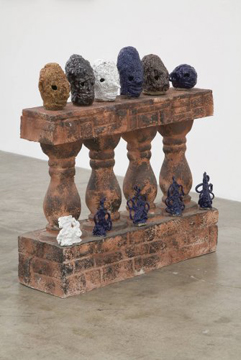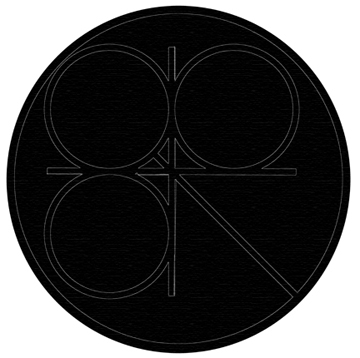Continued from “Gay Witches, Part 2”…
![“Ghost Boys [Massimo & Pierce]”, photo by Phillippe Christin, 2003. Courtesy of Black Sun Productions.](https://magazine.art21.org/wp-content/uploads/2008/12/ghostboys1.jpg)
3. The work of sound, visual, and performance artists, Massimo & Pierce, aka Black Sun Productions, could easily be discussed in the What’s So Shocking About Contemporary Art? thread on this blog. Their sexually explicit performances in Europe supposedly spurred police to raid their Zurich offices in 2003, although I haven’t been able to find any archived news items on this, other than anecdotal info on the Wikipedia entry on them and in reviews of their records. Not to cast doubt on the verity of these events, but Massimo & Pierce’s origin story itself has a mythological flair. After the two former sex workers met and became romantically involved, they decided to dedicate their partnership to an artistic and magical multimedia exploration of love. The duo take pornography seriously as an art form, casting it via sex magic as a theatrical ritual of transformation and connection. They achieved some international visibility in 2002 when they toured their Plastic Spider Thing performance with Coil. The performance was akin to an SM scene between two lovers’ spider and fly spirit animals. My favorite project by Massimo & Pierce, however, is less straightforwardly engaged with the symbols and processes of magic: their musical adaptation of the poetry and lyrics of Bertolt Brecht, operettAmorale. Musically, it is a combination of cabaret atmosphere, electronic drones, and chanted vocals. They manage to inject an extra dosage of darkness and debauchery into Brecht’s famously paradoxical words without seeming redundant. It is both disturbing and quite funny, particularly the campy “Pimp Ballad.” You can listen to some of their music on their Myspace page, as well as get additional information on their many different projects and collaborations.

4. William J. O’Brien is a Chicago-based artist who works in multiple media, including painting, sculpture, drawing, fiber, and ceramics, all of which he submits to an intuitive, seemingly casual sensibility. Most of his work has a rough, totemic quality that might superficially look like the type of work gathered for the Unmonumental show at the New Museum, but is ultimately too earthy and emotional to sustain that comparison for long. Credit those qualities of earthiness and emotion to O’Brien’s feel for materials and sense of touch. My favorite amongst O’Brien’s recent work are his ceramic heads, an installation of which are pictured above; a few more examples can be seen here. They make me think of Moche portrait vessels found in ancient tombs, only expressionistically rendered. The melted and scarred likenesses pinched and gouged from clay are like faces recalled from a nightmare or past-life regression. Or maybe O’Brien is recapping the Modernist principle of truth-to-materials as a kind of animism, as if it were the faces of spirits inhabiting the clay that he ultimately coaxed from the stuff.
I happily count O’Brien amongst my peers in Chicago. In conversation, he’s helped me greatly in thinking through the issues that are the topic of this post. He has noted, for instance, the link between magic and queerness in the Two-Spirit tradition of some Native American cultures as well as the conflation of witchcraft and deviance from gender norms during the witchhunts that haunt European history (think of the fate of the cross-dressing Joan of Arc).

5. In witchy fashion, we’ll come full circle back to AA Bronson and his Invocation of the Queer Spirits project, a collaboration with Peter Hobbs. In her introduction to an interview with Bronson about the project, Anne Pasternak recounts visiting the Lower 9th Ward with Bronson during a conference held in New Orleans:
There AA was powerfully overcome by the energy of spirits. He later shared that he had commenced a “queer séance” in Banff while on a recent residency there. He collaborated with Peter Hobbs, a fellow Canadian artist who uses drawings, photography, performance, video, installation and text to explore themes of gay male sexuality, witchcraft and heresy. Together they conjured the spirits of homosexuals from the recent and long past.
Bronson and Hobbs were subsequently commissioned to continue the invocations in different spiritually turbulent locations. Bronson goes into detail about the séance held in New Orleans this past Halloween in the interview:
The séances are designed in a format suitable to the history of the location: in New Orleans, we have devised a ritual that utilizes the methods of Afro-Caribbean spiritual traditions, especially Voodoo, together with the methods of European ceremonial magic. Peter and I have made this a major research project, investigating both the history of New Orleans—which is a strange and wonderful subject in itself—as well as Voodoo and the ancestral spirit-raising of the Mardi Gras Indians. We invited seven artists to participate … The actual event takes place in a secret place: we draw a circle, ask for protection, and invoke the spirits, naming the various histories and communities of the dead. … We each participate in a queer community of the living and the dead; the dead walk among us and are in subtle communication with us. Most societies acknowledge this relation to history and to our ancestors, but for some reason our society has lost this link to our own history.
I think the invisibility of Bronson and Hobbs’ project is compelling, given the art world context. A performance that no one sees (excepting the audience of spirits, of course) in a secret location? Most interesting for me, however, is their notion of queer ancestry. Queer folks, afterall, don’t constitute a race or nationality. Bronson and Hobbs’ concept of ancestry, of a deep continuity over many generations, is divorced from heredity, from blood-lines. I think that the subtext of their project, and the ground of possibility for imagining any kind of queer fraternity amongst the living and the dead, is that patriarchy is an ancient social structure from which we are not yet free. Queer pain runs historically deep. It is ancient too. In this connection, its useful to hear Bronson discuss his use of the word “queer” (in the same interview):
The concept of gayness is of course a modernist invention, and the word “queer” is an attempt to escape the limitations of that word. In the history of the world, magicians, shamans, mediums, priests, adventurers, and healers have always been more sexually ambiguous. … Artists and prostitutes traditionally also provide access from one world to another, and wherever you find a brothel, you will also find gay men. In the end, we have used the word queer to include all kinds of marginal and disenfranchised communities.
Also take a look at Peter Hobbs’ Queer Mountain site, which archives materials related to several collaborations with Bronson, as well as other works, including videos and drawings that humorously explore queerness in the context of nature and spirituality. I find the Faggot Patch, the Tree Hugger Ritual video, and the Bad Animals Manifesto particularly great.



